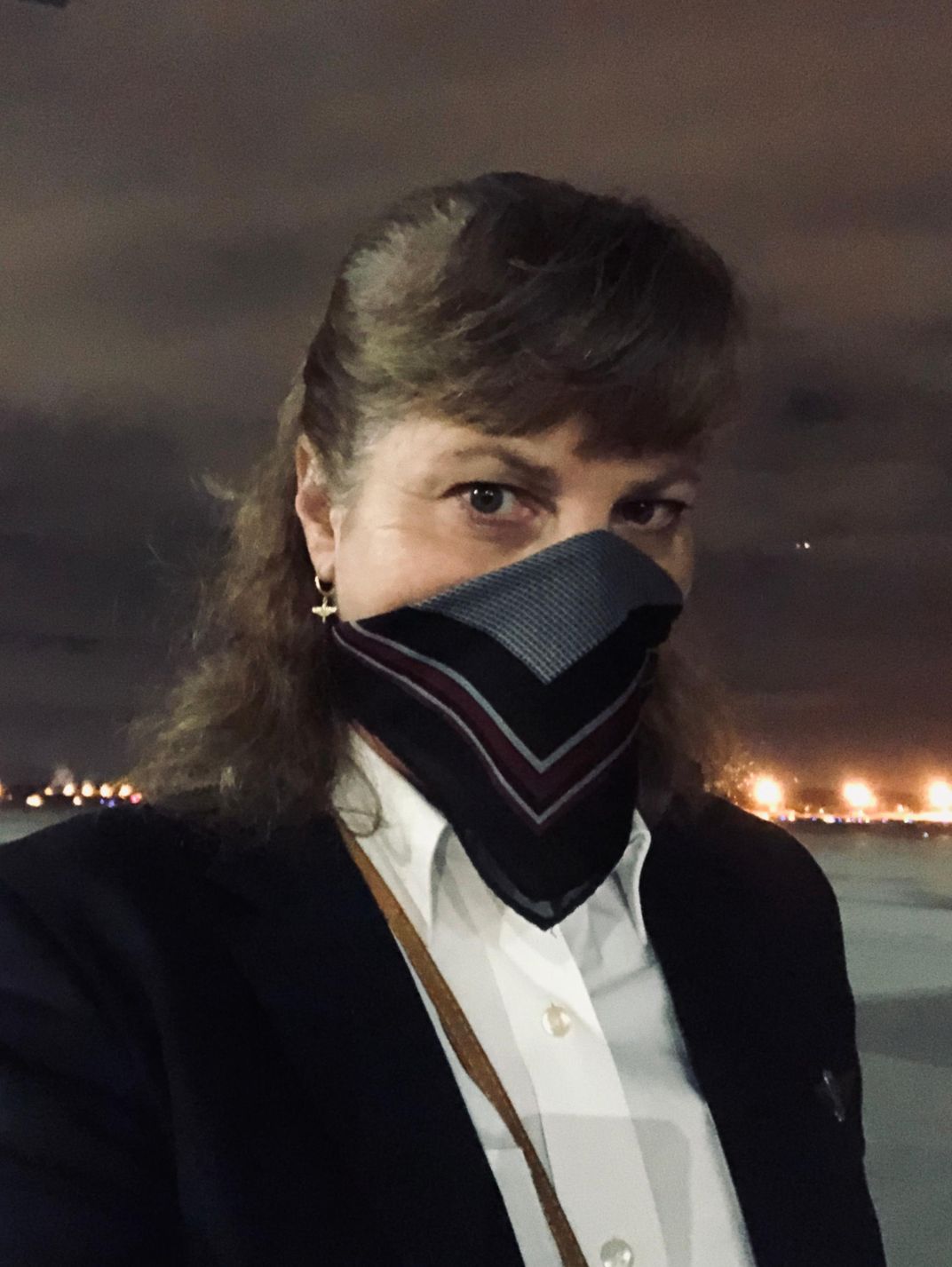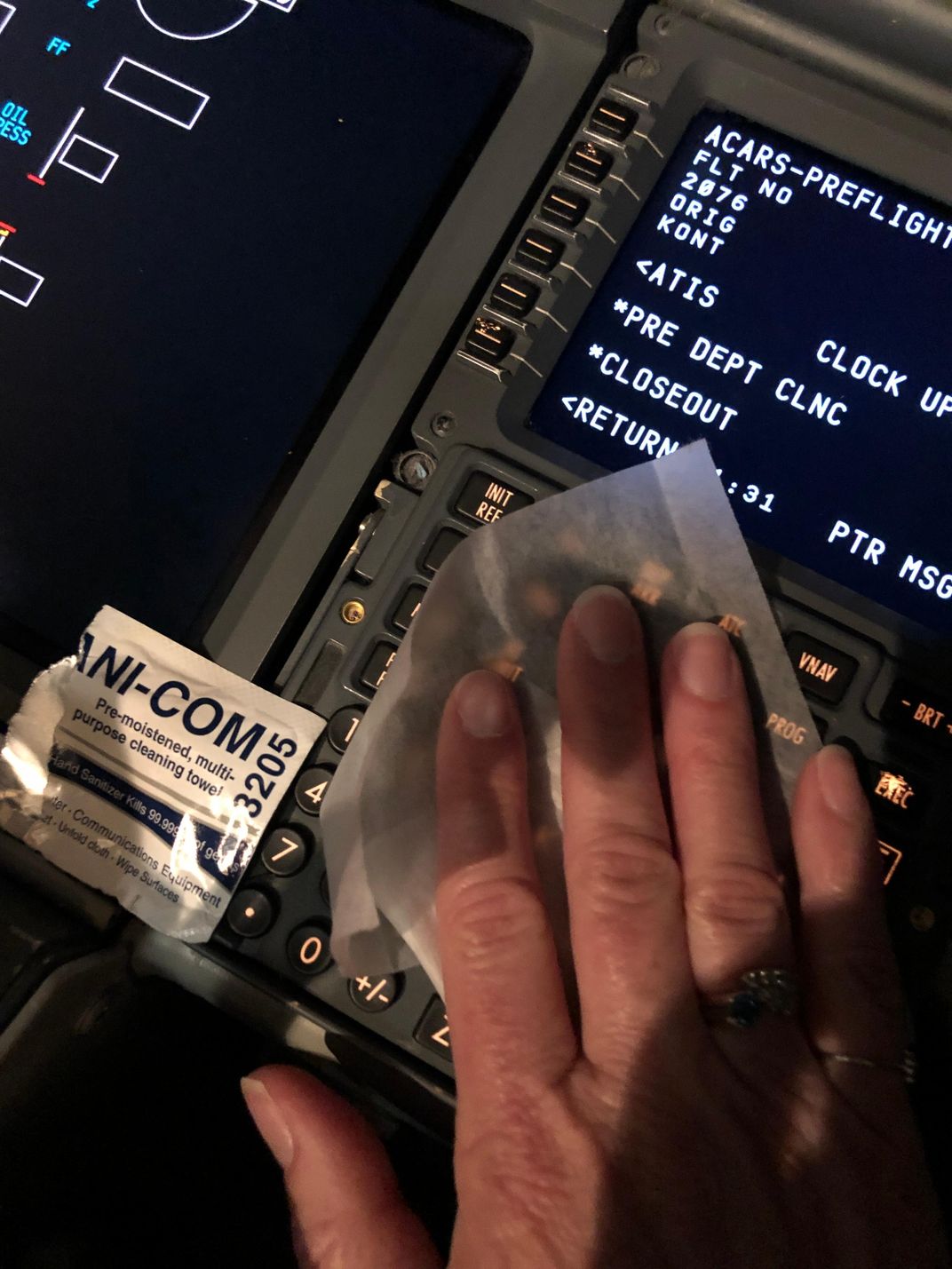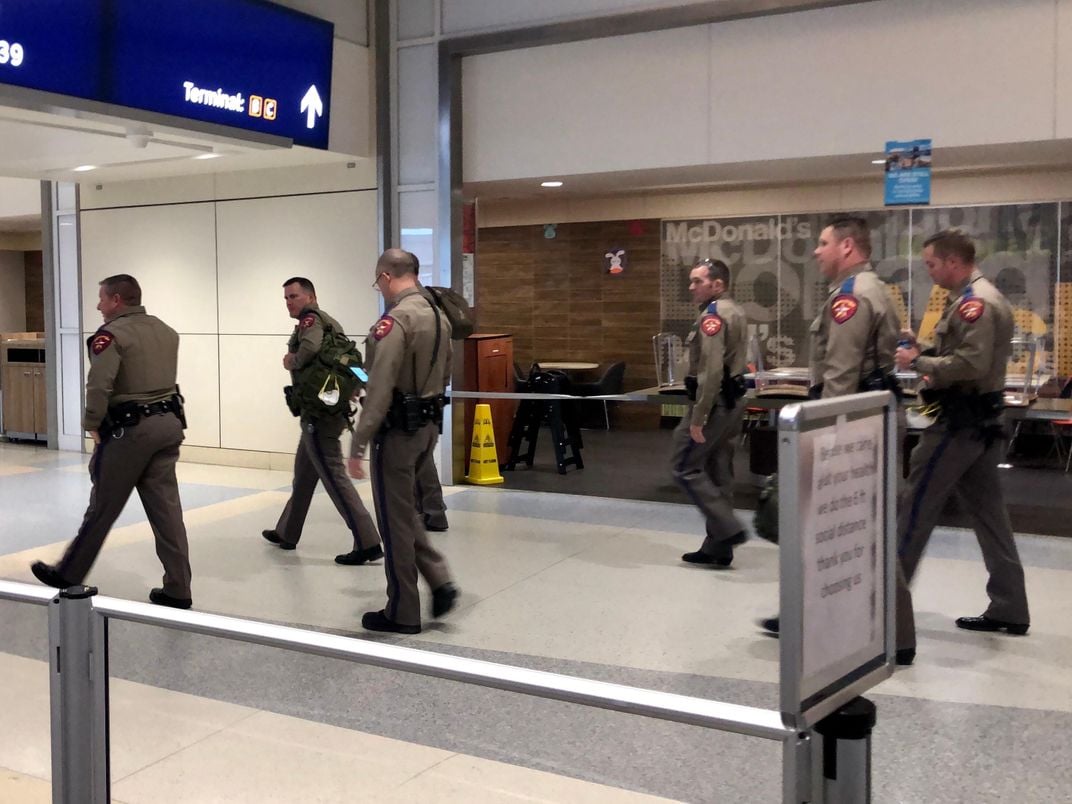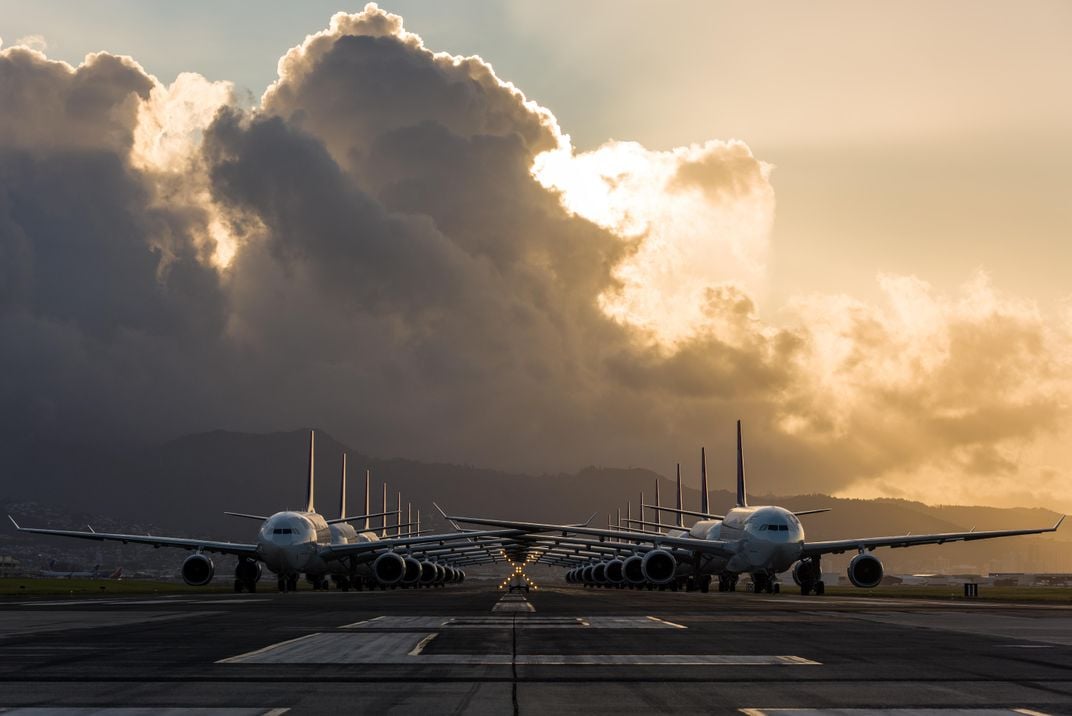Piloting Through the Pandemic
What it’s like to fly airplanes—when nobody is flying.
/https://tf-cmsv2-smithsonianmag-media.s3.amazonaws.com/filer/9d/d6/9dd6eefa-d7d1-4fe9-a3cc-3a7bc2b1fd26/spooky_cockpit.jpg)
The first signs seemed innocuous enough: I couldn’t get any coffee before my morning flight. All three Starbucks within a 1.5-mile radius of my home were closed. Thank God the several Starbucks in the terminal continue to operate, although by now, only essential-sector employees need coffee—everyone in line is in uniform.
In the cockpit, we are armed against the pandemic with a supply of Sani-Com wipes. Back in the day, before 9/11, cockpits were cleaned right along with the cabin. Somewhere between then and now, cockpit access was restricted to pilots and mechanics. Crumbs, chips, and peanuts also have seemingly unlimited access. Today, the first thing each pilot does after sitting down is to rip open the Sani-Coms and start wiping down surfaces: gear and flap handles, ACARS buttons (Aircraft Communications Addressing and Reporting System), temperature controls, fuel selectors, rudder-pedal knobs, radios, throttles, reversers, speed brakes, yoke and oxygen mask, etc. It takes at least two people to get the job done right.
Social distancing in the cabin or flight deck of a narrow-body jet is not an option. In the cockpit, we sit three feet apart. Nobody wants to wear an oxygen mask because we share them with all the other pilots flying the airplane. It was bad enough before all this started. Formerly, when one pilot left the flight deck, the remaining pilot would don his or her oxygen mask when cruising above 25,000 feet. The FAA recently amended that regulation to 35,000 feet. So now we’re relieved of the requirement to put on a germ-filled oxygen mask, unless there’s an emergency.
Contrary to popular belief, air circulating through the cabin flows through hospital quality HEPA filters. It’s not the recirculating air in the cabin that sickens you; it’s other passengers with colds who cough without covering their mouths. Our guidance during the pandemic tells us to keep air flow throughout the airplane whenever passengers are onboard at the gate. This can be accomplished in two ways—internally by running the Auxiliary Power Unit (APU) or externally by hooking up a hose that blows pre-conditioned air through the system. Not every gate has pre-conditioned air, and not every aircraft has a working APU. Who would have thought such a small thing like breathing would become so convoluted?
Almost every flight requires a hotel stay, and crews are constantly being relocated around the airline’s destinations to pick up flight assignments. Official guidance from the Department of Transportation and the airline tells us, “Stay in your hotel room and order room service.” Many of our hotels don’t have room service or a microwave. It is now recommended to pack and carry your own food on your trip.
I bid for flights that would offer Tucson layovers in April for my Mom’s 88th birthday, but because I’m likely exposed to the virus, I refrained from being the one to endanger her good health. Layovers in Portland are usually coveted. From the layover hotel, pilots can jump on the light rail downtown, walk to Powell’s Books, and browse for hours. But the bookstore is closed now. Who said reading material wasn’t essential? Especially when you’re stuck inside.
It took a pandemic for pilots deadheading in the cabin (to catch a ride to our next flight assignments) to be given a first-class seat. On this leg, three times more pilots are riding in the back of the plane than in the cockpit. And we’re all critiquing the landing. No one is going to live down a hard landing today, windshear be damned. I come back to reality when the flight attendant reminds me to put my seat back in the full upright position for landing. We’ve been reduced to armchair travelers on our way to another suspended state.

For today’s pandemic-induced musical chairs, we taxied back to the gate in Ontario, California, because as we taxied out to the runway, we received an ACARS message: “MAINTENANCE HOLD IN EFFECT CONTACT DISPATCH.” Our plane had evidently been parked for more than 48 hours, and the required Pitot Static check was not performed. Because we have so many off-duty planes, they’re running out of space to park, adding to the hazards and threats as we taxi around. Half the fleet sits on the ramp. Back at the gate, the mechanic pulls up a ladder to eyeball three pitot tubes and then makes a logbook entry.
Round two. We hold short of the runway. For another hour, we wait for dispatch to coordinate with maintenance to release our flight. Non-normal procedures are the new normal. They spring up like the possibility of a beehive or bird's nest in a pitot tube. We remain vigilant in the cockpit.
I’m not sure what Neil Diamond was referring to when he sang “Lonely Looking Sky,” but there are no planes, no clouds, and no contrails in the air. The Southern California airspace is no longer congested. Our Flight Plan now contains Covid Contingencies for diverting, uncontrolled tower operations, alternates, and fuel. More planes line up for takeoff as fewer runways are kept open for use. We hear that Kennedy, LaGuardia, and Newark (JFK, LGA and EWR to us) suspended takeoffs and landings. Orange County airport tower stopped operations unexpectedly, and Las Vegas is now uncontrolled. Departing Ontario in California’s Inland Empire, the region east of L.A., I hear the elevated stress levels of the southern California airspace controllers. They’re working multiple frequencies. We fly direct to a fix over 1,000 miles away because there’s no other air traffic there. We’re cleared straight up to cruise altitude: “Climb to 39,000 feet, unrestricted.” Not many of us choose to go up to 41,000 feet; if the virus doesn’t get us, the radiation will.
On our way to Dallas, we learn operations on half the airport have been shut down. The Automated Terminal Information Service (ATIS) texts us, “DFW WEST ATCT IS CLSD.” They’ve consolidated into a single tower. It’s IFR and the approach clearance for 17 Center doesn’t match our runway. The previous controller told us to expect 17 Left, a parallel runway. We’re no longer set up correctly on the flight deck to fly this approach. Since we’re in the clouds, we can’t just look out to the neighboring runway to land visually. The tower has to vector us around the airport again and apologizes for the miscommunication. Good thing we added Covid Contingency fuel.

Everything we pass is eerie and empty: terminals, baggage claims, and TSA lines. It’s a quick drive to the airport because no one is on the highway. Airline employees park in the paid passenger lots—commonly referred to as “princess parking”—closer to the terminal because we’re the only ones there. But for strange sites, this one takes the cake: As we deplaned in Dallas, no fewer than nine State Troopers met our aircraft to enforce the state’s 14-day quarantine mandatory for passengers arriving from an expanded list of epicenter cities and states: NY, CT, NJ, CA, LA, WA, Atlanta, Miami, Detroit and Chicago. They collect declaration-like forms with contact information for passengers whose final destination is in Texas. Enforcement includes unannounced visits to verify compliance. The penalty is a $1,000 fine and six months in jail. If you have a boarding pass for a connecting flight or are an essential-sector employee, you are exempt from their welcome.

We’re starting our descent into the fog. Last night I dreamt I had hairy feet like a hobbit. I never dreamed that before. The online Dream Directory said: “A dream about hairy feet is a harbinger for a need for relaxation and a long-deserved break. Hairy feet is about an escape from the stressful realities in your life.” Sorry I asked.
For April Fool’s Day, Leaves of Absence were announced. Based on seniority, anyone within three years of retirement was offered paid early retirement. This effort was made in hopes of mitigating the number of junior pilots likely to be furloughed in the fall. Almost immediate effective retirement dates meant that some captains were literally flying their last trip before they knew it. A bittersweet reality for what should have been a momentous occasion for 616 pilots at the top of the seniority list. Unfortunately, losing their dream job is what’s on the mind of hundreds of new probationary pilots still in their first year. It remains to be seen what happens after September when the stimulus package allows the airlines to begin furloughs. Leaves of Absence for the rank and file were initially offered, rescinded, and offered again with a delayed effective date. Our monthly schedules are delayed. Seemingly, it’s becoming difficult to determine how many planes and pilots are on the line, so we all stand by at the ready for whatever comes down the pike. Now who’s the April Fool?

My recurrent training was canceled while the training center is closed. Those of us still flying the line have had our training currency extended by two extra months and medical expiration dates extended for 90 days. I might consider a leave of absence in June, but I like to work. Being an airline pilot is a lifestyle, and I don’t want to stay home. But the supporting infrastructure is crumbling around us. Every time someone else drops the ball, we’re left juggling.
Each day more of our standard operating procedures are dismantled, replaced by a pandemic response. One begins to question the soundness of flying near-empty airliners.
Thrusting crews into coronavirus epicenter city hotel rooms, shuttle buses, and airport terminals increases our odds of getting and spreading the virus to our community. But pilots will continue to rise above, just as we did post 9/11. For a second time, both pilot and passenger are reminded: It is a privilege to fly our open skies.
Andrea Eldridge is a pilot for a major U.S. airline.